There’s nothing quite like the mouthwatering experience of rotisserie grilling, where your meals are infused with flavor and even cooking. To ensure your cooking adventures are both enjoyable and successful, you’ll need a selection of necessary tools designed for precision and ease. In this guide, we’ll examine the must-have gadgets and accessories that will elevate your rotisserie game, making it easier for you to achieve perfectly cooked meats with that irresistible crispy skin every time. Get ready to transform your grilling experience with the right equipment at your side!
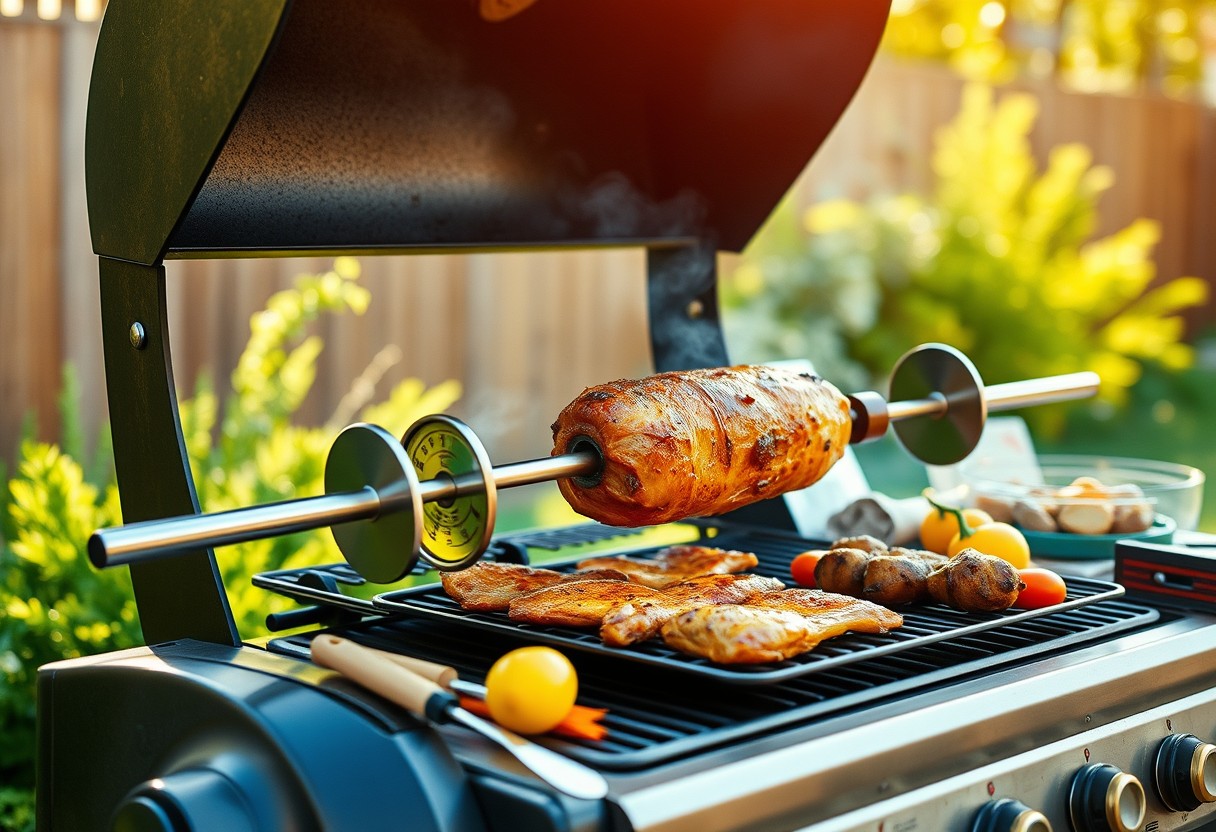
Key Takeaways:
- High-Quality Grill – Investing in a reliable rotisserie grill ensures even cooking and outstanding flavor every time.
- Essential Accessories – Tools such as rotisserie forks, baskets, and a reliable meat thermometer enhance your grilling experience and help achieve perfection.
- Preparation and Marinades – Marinating your meats and prepping ingredients effectively contributes to depth of flavor and tenderness, making your grilling adventures truly memorable.
Understanding Rotisserie Grilling
Your journey into the world of rotisserie grilling begins with understanding its unique qualities and the techniques that make it a favorite among grilling enthusiasts. This method involves cooking food on a spit, rotating it slowly over a heat source, which allows for even cooking and mouthwatering results. Mastering the art of rotisserie grilling can elevate your outdoor cooking game, producing tender and juicy meats that are packed with flavor.
The Evolution of Rotisserie Grilling
Rotisserie cooking has roots that stretch back to ancient civilizations, where it was used as a method for preparing meat over open flames. In medieval times, large spits were rotated by hand or facilitated by animals, making this technique both practical and communal. Over the centuries, advancements in technology led to the creation of more sophisticated rotisserie units, transitioning from the simple spit to the modern rotisserie grill that many use today. This evolution has brought convenience and accessibility to outdoor enthusiasts, allowing you to explore rotisserie grilling in your backyard with ease.
As grilling techniques evolved, so did the understanding of flavor profiles and cooking methods. Innovations such as temperature control and electric motors have transformed rotisserie grilling into an art form, enhancing the overall experience. In contemporary kitchens and patios, you’ll find a plethora of rotisserie grills, each offering unique features to aid in your grilling adventures, marrying ancient practices with modern engineering.
Benefits of Rotisserie Cooking
For those who appreciate the depth of flavor and texture, rotisserie grilling offers multiple benefits. One of the most significant advantages is the ability to achieve even cooking, which minimizes the risk of overcooked or undercooked meat. As the spit rotates, it baste meats in their juices, yielding a consistently moist product and a crisp, caramelized exterior that leaves your taste buds wanting more.
To further enhance your grilling experience, rotisseried meats can also be seasoned and marinated to create complex flavor profiles that can be tailored to your preferences. The gentle rotation allows for marinades and rubs to penetrate deeply into the meat, which is often more difficult to achieve through traditional grilling methods. Moreover, as the drippings fall onto the heat source, they create a delicious smoke that infuses your food with a rich, savory essence.
The Science Behind Rotisserie Grilling
One of the appealing aspects of rotisserie grilling is the science involved in cooking meat evenly. When meat is placed on the rotating spit, its even exposure to heat ensures that all parts cook at a similar rate, minimizing temperature differences that can lead to inconsistencies. The constant movement helps in rendering fat, while the juices circulate back into the meat, enhancing flavor and texture ranging from succulent to perfectly crisp.
This scientific approach doesn’t just optimize cooking; it also influences how heat transfers during the process. The combination of direct and indirect heat allows for the Maillard reaction— a chemical reaction that occurs when meat is seared, creating that coveted brown crust and deep flavors. Understanding this process can empower you to adjust temperatures and times to achieve the ideal results every time you fire up your rotisserie.
Must-Have Equipment
Little do many realize, the key to a successful rotisserie grilling adventure lies not just in the recipes you choose but also in the equipment you use. If you want to become a master of rotisserie grilling, investing in the right tools is crucial. Every grill master needs a well-equipped setup to ensure that your meats come out perfectly tender and flavorful every time.
Types of Rotisserie Grills
Any experienced griller knows there are various types of rotisserie grills available on the market today. When considering which option is best for you, think about your grilling style and needs. Here’s a quick breakdown of some popular choices:
| Type | Description |
| Charcoal Rotisserie | Offers a smoky flavor, ideal for traditionalists |
| Gas Rotisserie | Convenient for quick cooking with precise temperature control |
| Electric Rotisserie | Easy to use and often portable for small spaces |
| Pellet Grill Rotisserie | Combines smoking and grilling for versatility in flavors |
| Infrared Rotisserie | Cooks food evenly while retaining moisture |
- Consider your cooking preferences and space limitations
- Choose a grill that complements your outdoor setup
- Look for features such as adjustable heat settings
- Invest in quality materials for durability
- This decision will enhance your grilling proficiency.
Essential Tools for Setup
The success of your rotisserie grilling experience also depends on having the right setup tools. This includes not only the grill itself but additional equipment that aids in the preparation and cooking processes. A good rotisserie setup usually involves a motor, spit rod, and forks that secure your meat.
This assortment allows you to rotate your food evenly, promoting thorough cooking. You should also consider tools like heat-resistant gloves, basting brushes, and a reliable meat thermometer to monitor doneness accurately. Without these important tools, achieving the perfect rotisserie dish could become a challenging endeavor.
Accessories to Enhance the Experience
Types of accessories can significantly enhance your rotisserie grilling experience and elevate the flavor profiles of your meals. These can range from marinating injectors and spice rubs to specialized rotisserie baskets for vegetables and other side dishes. Investing in these accessories not only expedites the cooking process but can also impress your guests with culinary finesse.
Equipment such as grilling aprons and utensils also plays a part in enhancing your overall grilling experience. Quality tongs, spatulas, and carving knives ensure that you have the tools necessary for both preparation and serving. This lets you focus on enjoying your grilling adventure rather than worrying about how your food is handled or presented.
Safety Gear for Grilling
Equipment safety gear is non-negotiable when undertaking any grilling adventure. Protective gloves, an apron, and heat-resistant gear will keep you safe from burns and hot surfaces while managing your grill. Additionally, a safe grilling environment helps you prevent accidents, so consider a fire extinguisher and a first-aid kit nearby as precautionary measures.
This proactive approach to safety will give you peace of mind as you master the art of rotisserie grilling. Always remain vigilant while cooking, as the heat and flames can pose serious risks. Investing in proper safety equipment guarantees that your cooking remains a joyful, worry-free experience.
Safety in the kitchen translates to a more enjoyable grilling experience. Make sure you choose safety gear that is comfortable yet protective, so you can focus on perfecting your grilled masterpieces without distraction.
Preparing for Your Rotisserie Adventure
Now that you’re ready to begin on your rotisserie grilling adventure, proper preparation is key to ensuring a delightful cooking experience. You’ll want to consider several imperative elements that will greatly enhance your grilling journey, starting from selecting your meat to understanding ideal cooking times. Each step is integral to achieving that perfect, succulent meal that everyone will enjoy.
Choosing the Right Meat
One of the most crucial decisions you’ll make is choosing the right meat for your rotisserie grill. Rotisserie cooking is ideal for larger cuts of meat, as the even rotation helps to baste the meat in its own juices, resulting in a tender and juicy end product. Common choices include whole chickens, pork loin, or even larger cuts of beef like prime rib. Look for meat that has a good balance of fat to ensure flavor and moisture throughout the cooking process.
One important tip is to consider the size of your rotisserie attachment when selecting your meat. It’s imperative that the cut you choose fits comfortably on the spit without any part of it dragging along the grill or getting caught in the mechanism. As a rule of thumb, opt for cuts that vary in size rather than one large piece if you are unsure how your equipment will handle them.
Marinades and Seasoning Techniques
One of the best ways to elevate your rotisserie meat is by investing time into your marinades and seasoning techniques. Marinades not only add flavor but can also help to tenderize the meat by breaking down its fibers. Common ingredients to include are acidic elements like vinegar or citrus juice, along with herbs, spices, and oils. Be sure to marinate your chosen meat for at least a few hours, or even overnight, for optimal flavor infusion.
Complementing your marinade with an additional rub can further enhance the flavor profile. A dry rub made from spices such as paprika, garlic powder, and brown sugar can create a crunchy crust while retaining moisture within. Be mindful of how much seasoning you apply, as you want to avoid overpowering the natural flavors of the meat.
The best marinades often combine acid, oil, and various spices to bring depth to the dish. A great example is a simple mixture of olive oil, lemon juice, garlic, and rosemary. This combination not only tenderizes but adds a refreshing flavor that complements rotisserie chicken perfectly. Always remember to reserve some marinade aside before you place the meat on the grill, so you can use it to baste while cooking for additional moisture and richness.
Understanding Cooking Times and Temperatures
Your success in rotisserie grilling largely depends on your understanding of cooking times and temperatures. Every type of meat requires different cooking durations and heat settings to ensure it’s cooked properly while staying flavorful and juicy. As a general guideline, you might refer to the table below to plan your grilling effectively.
| Meat Type | Cooking Temperature (°F) |
| Whole Chicken | 350°F |
| Pork Loin | 375°F |
| Prime Rib Roast | 325°F |
Preparing for rotisserie grilling means being equipped with adequate knowledge on how different meats cook. Pay attention to internal temperatures to ensure food safety; for example, chicken should be cooked to a minimum internal temperature of 165°F, while pork and beef require 145°F and 135°F respectively for safe consumption. Using a reliable meat thermometer is invaluable in this respect to help you monitor progress without having to constantly cut into the meat.
| Meat Type | Minimum Internal Temperature (°F) |
| Chicken | 165°F |
| Pork | 145°F |
| Beef (Medium Rare) | 135°F |
Preparing for your rotisserie adventure properly means investing time into knowing not just the types of meat and marinades but also their cooking nuances. With this thorough understanding, you’ll set the stage for a memorable and delicious grilling experience.
The Cooking Process
All successful rotisserie grilling adventures begin with a clear understanding of the cooking process. This method not only allows for even cooking and flavor infusion but also results in a beautifully browned exterior. To ensure your grill is set up for success, consider the following steps.
Setting Up Your Grill
An important first step in rotisserie cooking is properly setting up your grill. Begin by confirming that your rotisserie attachment is securely mounted and functioning correctly. If you’re using a charcoal grill, arrange your coals for indirect heat and allow them to reach the right temperature, ideally between 300°F and 350°F. For gas grills, set the outside burners on medium heat and leave the center burner off to create a hot zone and a cooler zone for cooking.
Once your grill is prepared, it’s time to incorporate flavor. You can enhance your cooking experience by adding wood chips to create smoke, injecting marinades into the meat, or utilizing a dry rub. These preparations will contribute to the depth of flavor as you rotate your meat over the heat, ensuring every bite is infused with deliciousness.
Properly Securing the Meat
Setting your meat up correctly is crucial for achieving an evenly cooked and juicy masterpiece. Begin by choosing a cut of meat that is well-marbled; this will help maintain moisture and flavor during the cooking process. To secure the meat, you must thread it onto the rotisserie skewer, ensuring it fits snugly without being overly tight, as this might restrict the heat circulation. Use butcher’s twine or metal clamps to secure the ends, which helps to hold the meat in place throughout the cooking cycle.
Grilling with a rotisserie means you want stability. If your meat shifts during cooking, it can cause uneven cooking and potentially lead to flare-ups. Check for any loose areas before turning on your grill, ensuring everything is tightly secured. By taking the time to properly secure your meat, you set the stage for a seamless and successful cooking process.
Monitoring the Cooking Progress
Any seasoned rotisserie griller knows that monitoring the cooking progress is key to achieving perfectly cooked meat. As your grill heats up and your meat begins to spin, pay attention to the changes in color and texture. It’s important to avoid constant opening of the grill door, as that could cause fluctuations in temperature and prolong cooking time. Instead, use a probe thermometer to keep tabs on the internal temperature without compromising heat retention.
While cooking, it’s beneficial to rotate the skewer occasionally, particularly if you notice specific hot spots within your grill. This practice ensures all sides of your meat receive even exposure to the heating element. Keep in mind, patience is vital; some cuts, especially larger ones, may require more time than anticipated, so continually monitor and adjust as necessary.
Progress is fundamental when rotisserie grilling; understanding when to baste or rotate the meat can elevate flavors and textures. As you observe your meat cooking, you may want to apply marinades or sauces periodically for added moisture and taste. By developing a keen eye for monitoring the cooking process, you’ll refine your grilling skills and achieve exceptional results every time.
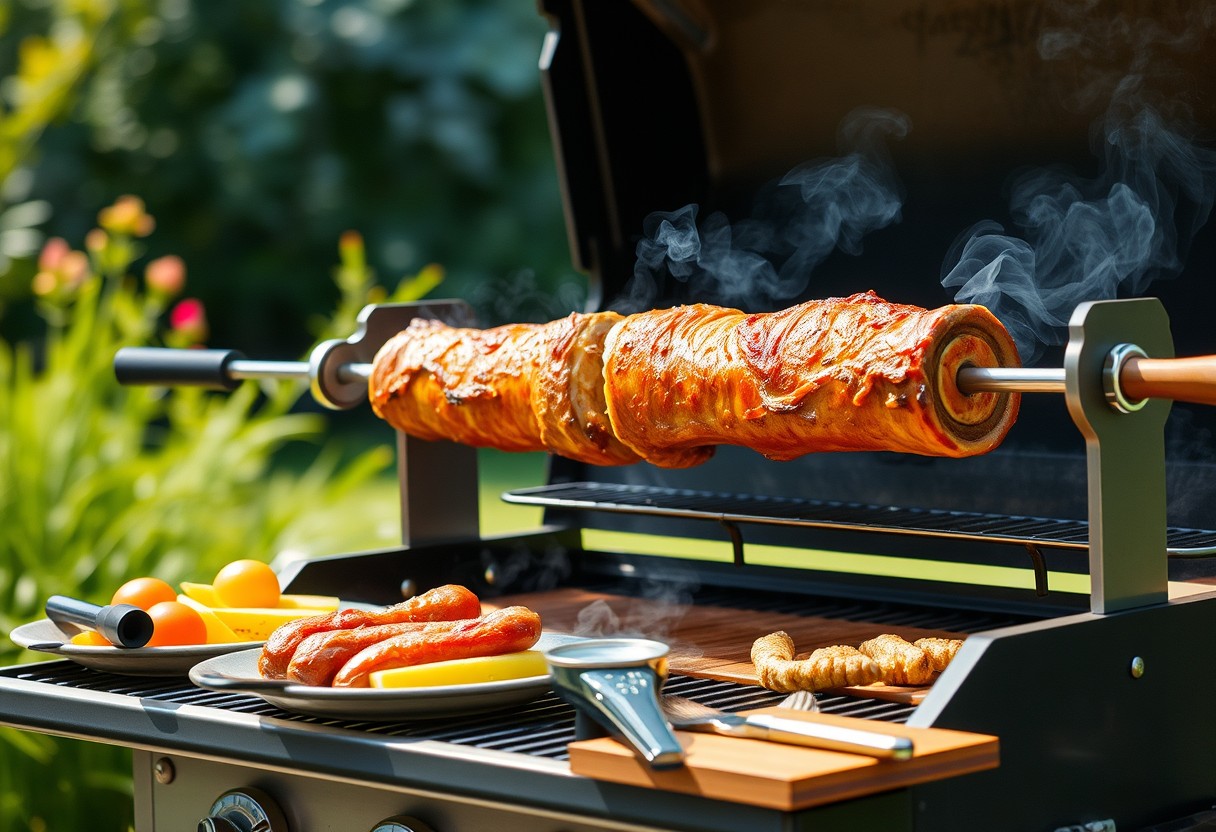
Flavoring Techniques
Once again, you have the opportunity to elevate your rotisserie grilling experience by mastering various flavoring techniques. These methods will enhance the depth and character of your grilled dishes, ensuring that every bite is full of rich, satisfying tastes. From smoky infusions to tantalizing herb blends, understanding these techniques can make all the difference in your grilled offerings.
Wood Chips and Smoky Flavors
On your journey through rotisserie grilling, incorporating wood chips can introduce a magnificent smoky flavor that will impress your guests. Different types of wood provide distinct aromas and tastes. For example, hickory offers a robust, bacon-like flavor, while applewood gives a subtly sweet touch that complements poultry beautifully. Consider soaking the wood chips in water for about 30 minutes before use to create a fragrant steam that will enhance the flavor profile without burning too quickly.
Experimenting with various wood chip blends can also lead you to discover unique flavor combinations. Combining hickory and applewood, for instance, strikes a balance between strong and subtle, creating depth in your grilled meats. Always remember to add the wood chips gradually throughout the grilling process, allowing your rotisserie to achieve a well-rounded smokiness without overwhelming the other flavor components.
Basting: A Step-by-Step Guide
StepbyStep, basting is one of the most effective techniques that you can employ while grilling on a rotisserie. Basting not only keeps your meat moist during the cooking process but also enhances the flavors significantly. Here’s a breakdown of how to perfect your basting technique:
| Step | Description |
| 1 | Prepare your basting mixture using your favorite oils, herbs, and seasonings. |
| 2 | Once the meat is in the rotisserie, start basting it after the first 30 minutes of cooking. |
| 3 | Use a basting brush or a turkey baster for even application. |
| 4 | Baste every 15-20 minutes for the best flavor infusion and moisture retention. |
With each basting session, you’ll notice how the flavors meld beautifully into your meat, enhancing your dish’s overall complexity. Basting not only adds moisture but also creates a glorious caramelization on the surface of the meat. This process allows you to explore different flavor profiles with each grilled creation, making your meals unique to your taste.
Utilizing Herbs and Spices
Utilizing fresh herbs and spices is another powerful way to infuse flavor into your rotisserie grilled dishes. The versatility of herbs like rosemary, thyme, and parsley allows you to pair them with various types of meat, creating a delightful aroma. When preparing your seasoning mix, consider combining dried spices such as paprika, garlic powder, and cumin for an extra layer of flavor. Each herb and spice offers distinct characteristics that can transform your grilling experience.
With a bit of experimentation, you will discover that herbs can be used both as a marinade base and for placing inside the cavity of poultry. This will enhance the flavor from the inside out and elevate your dish to gourmet standards. Remember to be liberal with your herb usage; fresh herbs hold incredible flavor that can penetrate through the cooking process, resulting in a beautifully aromatic final product.
With your newfound knowledge of flavoring techniques, you can confidently venture into your rotisserie grilling adventures, knowing that every choice you make adds another layer of deliciousness to your dishes.
Serving and Pairing Suggestions
After you’ve perfected your rotisserie grilling techniques, the next step is to think about how to present and enjoy your delicious creations. Serving your rotisserie meats in an enticing manner can elevate your dining experience and make your hard work all the more rewarding. To achieve this, consider using a large wooden serving board or a beautiful platter that complements the colors of your dishes. Fresh herbs, citrus slices, or edible flowers can be strategically placed around the meat for a pop of color, while dipping sauces or salsas can be served in small bowls for added flair. Note, presentation is key to making your meal visually appealing.
Presentation Tips for Rotisserie Dishes
In addition to the serving vessels, think about the layout of your meal. Instead of placing everything in a haphazard manner, arrange your rotisserie meats alongside thoughtful accompaniments that showcase their flavors. Try to create height and dimension by stacking slices or arranging pieces in a spiral pattern. Adding garnishes not only enhances aesthetics but also provides additional flavor. Here are some vital presentation tips:
- Use contrasting colors for sides and garnishes to make the dish pop.
- Invest in quality dinnerware that enhances the overall presentation.
- Slice meats just before serving to keep them juicy and appealing.
- Incorporate seasonal elements for a fresh and inviting look.
- After the meal, take a moment to photograph your masterpiece before it disappears!
Perfect Side Dishes for Rotisserie Meals
Perfect rotisserie meals deserve side dishes that complement and enhance your grilled flavors. Think about classic options such as roasted vegetables, which can be easily prepared on the grill alongside your meat. A clever mix of seasonal veggies like bell peppers, zucchini, and asparagus can bring freshness and color to your plate. Additionally, consider light and zesty salads, such as a Mediterranean quinoa salad or a crisp coleslaw, to balance the richness of your rotisserie dish.
Another great side dish choice is a creamy potato salad or buttery corn on the cob, both of which provide a comforting contrast to the smoky notes of your grilled meat. Grilled sides add an additional layer of flavor, allowing the char and seasoning from the grill to shine through. With the right combinations, you not only create a satisfying meal but also a well-rounded experience that will leave your guests raving about your culinary skills.
Beverage Pairing Ideas
Ideas for beverages to accompany your rotisserie meals can make a significant impact on the overall dining experience. Beer lovers might gravitate towards a pale ale or a lager, both of which can complement the charred flavors of grilled meats while cutting through the richness. For those who prefer wine, a light Pinot Noir or a crisp Chardonnay can enhance the dish without overpowering it. Don’t forget about non-alcoholic options, such as sparkling water with fresh lime or a refreshing iced tea infused with peaches, which can serve as delightful palate cleansers.
Dishes with bold flavors, like barbecue chicken or lemon-herb rotisserie, particularly benefit from thoughtful beverage pairings that enhance their distinctive profiles. You could try offering a signature cocktail that features ingredients used in your meal, such as a citrus-infused gin and tonic. Tailoring your drink selection to match the flavor notes of your rotisserie dishes will create a harmonious and memorable dining experience for you and your guests.
Troubleshooting Common Issues
Unlike other grilling methods, rotisserie grilling can present some unique challenges. Whether you are a novice or have some experience, knowing how to troubleshoot common issues can enhance your grilling adventures and yield delicious results. From uneven cooking to flare-ups and maintenance concerns, addressing these challenges effectively will ensure your next rotisserie session is a success.
Handling Uneven Cooking
For many grillers, uneven cooking can be frustrating, especially when one side of your meat is perfectly cooked while the other remains underdone. This issue often arises from improper heat distribution or positioning on the rotisserie. To combat this, you should regularly check the alignment of your spit and ensure that the meat is centered. Additionally, consider using a meat thermometer to monitor the temperature on both sides, allowing for more precise cooking adjustments.
Another effective strategy is to rotate your meat during the cooking process, especially if you notice one side is cooking faster than the other. This can help achieve a more uniform cook while keeping your meat juicy and delicious. Understanding your grill’s hot spots, whether by experimentation or through practice, can also contribute significantly to mitigating this issue.
Dealing with Flare-Ups
Issues can arise during the grilling process, particularly when fats from your meat drip onto the flames. Flare-ups can cause charring and burnt flavors that detract from the overall quality of your meal. To manage this, make sure to trim excess fat from your meat before grilling to reduce the chances of flare-ups occurring. In addition, you can position a drip pan beneath the meat to catch any drippings and prevent them from igniting.
Another effective technique is to have a spray bottle filled with water handy. When a flare-up occurs, quickly douse the flames with water to bring them under control without losing precious cooking time. You can also move the meat to a cooler part of the grill until the flames subside before returning it to its ideal position.
Tips for Cleaning and Maintenance
Tips for maintaining your rotisserie grill include regular cleaning and upkeep to ensure optimal performance. After each use, be sure to remove any food particles from the grill grates, the spit, and the motor. Use a grill brush to scrub off residue and make cleaning easier during your next grilling session. Additionally, check the motor and battery regularly to ensure everything operates smoothly and safely. Always refer to your grill’s manufacturer instructions for specific cleaning guidelines and parts maintenance.
- Clean the cooking grate and under the spit after each use.
- Regularly check and replace worn-out parts, like the motor or battery.
- Spray with cooking oil before grilling to prevent sticking.
- Store your grill in a dry place to avoid rust.
The overall longevity and efficiency of your rotisserie grill significantly depend on how well you maintain it. By incorporating preventative measures and cleaning routines, you can enjoy countless grilling adventures without the hassle of equipment breakdowns.
- Schedule deep cleaning sessions every few months to tackle tough grime.
- Invest in grill cover to protect from dirt and environmental elements.
- Inspect the spit rod and forks for wear and tear regularly.
Understanding the importance of proper cleaning and maintenance will not only enhance your grilling experience but also extend the lifespan of your rotisserie grill. Your investment deserves the best care, so prioritize upkeep to enjoy delicious grilled meals for years to come.
Summing Up
Upon reflecting on the important tools for successful rotisserie grilling adventures, it becomes clear that the right equipment significantly enhances your cooking experience. Investing in a reliable rotisserie attachment, high-quality skewers, and comprehensive grilling utensils sets the stage for achieving perfectly cooked meats infused with flavor and tenderness. Moreover, don’t forget the importance of a good thermometer and marinade injectors to account for temperature control and flavor depth, respectively. When you equip yourself with these tools, you not only elevate your grilling skills but also ensure that every meal is a culinary delight, filled with juicy and succulent results.
Additionally, as you launch on this grilling journey, remember that mastering your rotisserie techniques will take practice and patience. Familiarize yourself with your equipment, experiment with different marinades and cooking times, and pay attention to the specific needs of the meats you are preparing. In doing so, you’ll transform ordinary gatherings into unforgettable feasts, impressing friends and family with your newfound expertise. Embrace the adventure, and let your passion for rotisserie grilling create delicious memories around the fire.

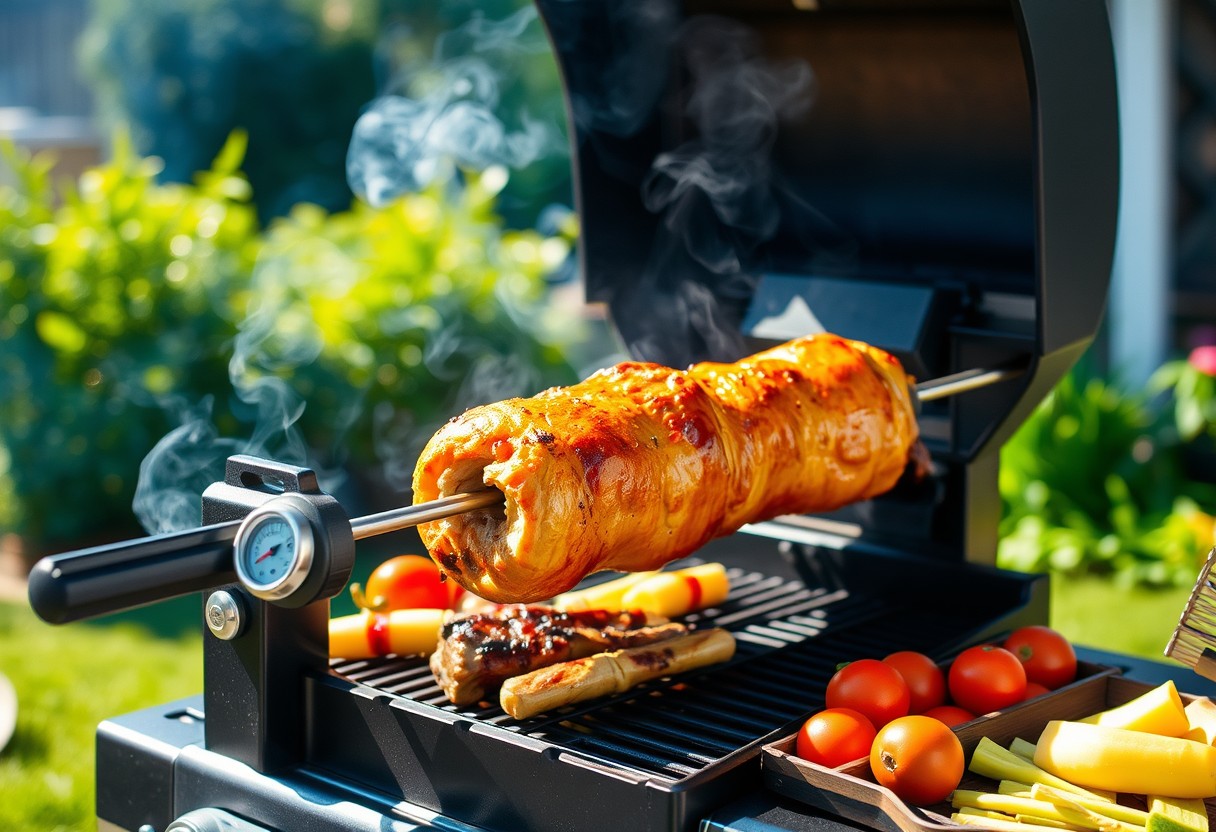
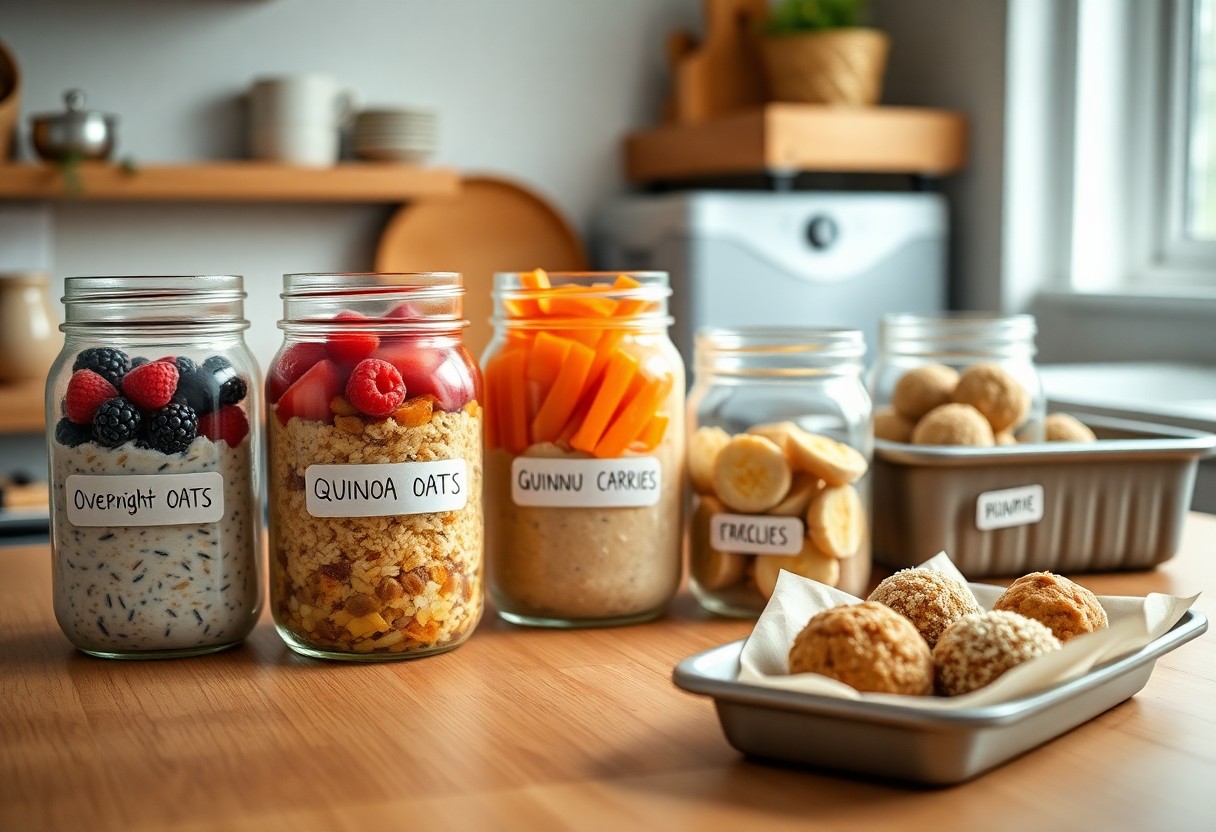
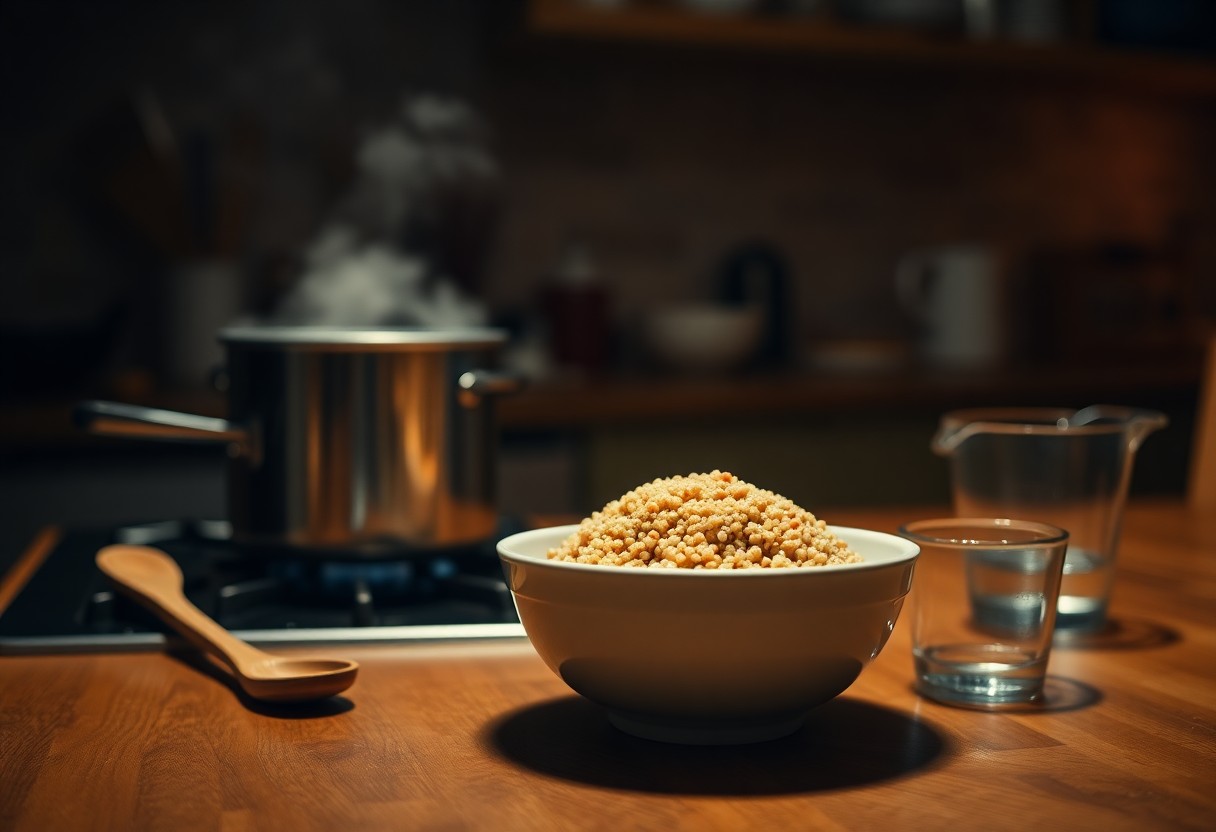

Leave a Reply